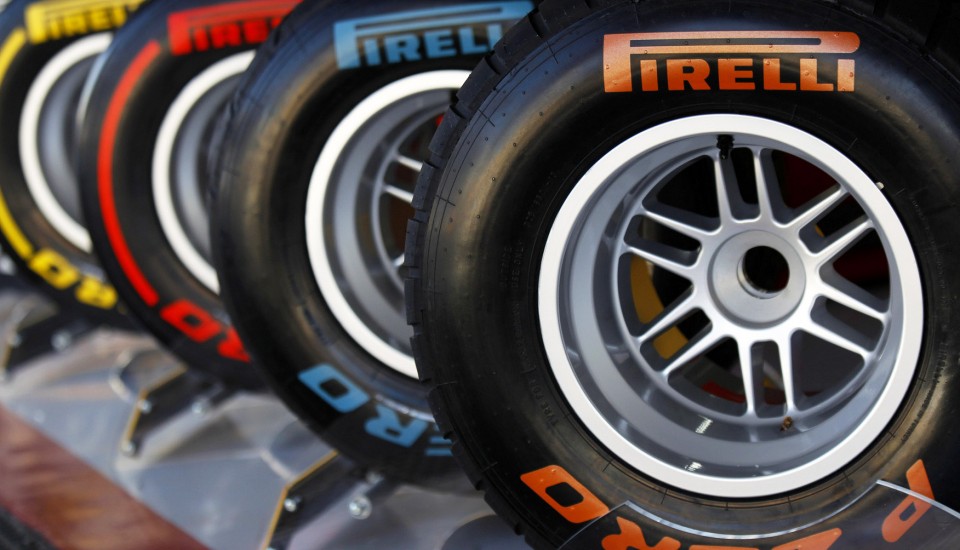Tyres Explained
You will find the size of a tyre on its sidewall. With a quick explanation as to what the different numbers mean, you will see that it is very quick and very easy to find out a tyre's size.
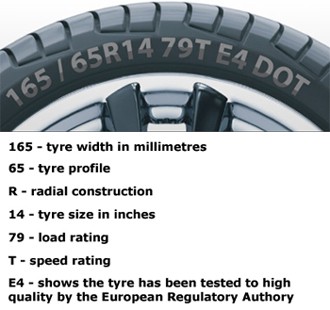
Speed Rating Table
The code relating to the speed rating is usually displayed just after the load capactity of the tyre, for example: 195/45 R16 85 V.
| Speed Rating | Mile/Hour | Kilometers/Hour |
| N | 87 | 140 |
| P | 93 | 150 |
| Q | 99 | 160 |
| R | 106 | 170 |
| S | 112 | 180 |
| T | 118 | 190 |
| U | 124 | 200 |
| H | 130 | 210 |
| V | 149 | 240 |
| Z | 150+ | 240+ |
| W | 168 | 270 |
| Y | 186 | 300 |
Load Capacity Table
Each tyre manufactured and regulated by the European Regulatory Authorities has a load capacity, this is the weight the tyre can safely handle and can be checked using the manufacturers guidelines.
The code relating to the load capacity is found on the tyre wall and is usually displayed before the speed rating, for example: 195/45 R16 85 V.
| Load Index | Load In KG | Load Index | Load In KG | Load Index | Load In KG |
| 62 | 265 | 84 | 500 | 106 | 950 |
| 63 | 272 | 85 | 515 | 107 | 975 |
| 64 | 280 | 86 | 530 | 108 | 1000 |
| 65 | 290 | 87 | 545 | 109 | 1030 |
| 66 | 300 | 88 | 560 | 110 | 1060 |
| 67 | 307 | 89 | 580 | 111 | 1090 |
| 68 | 315 | 90 | 600 | 112 | 1120 |
| 69 | 325 | 91 | 615 | 113 | 1150 |
| 70 | 335 | 92 | 630 | 114 | 1180 |
| 71 | 345 | 93 | 650 | 115 | 1215 |
| 72 | 355 | 94 | 670 | 116 | 1250 |
| 73 | 365 | 95 | 690 | 117 | 1285 |
| 74 | 375 | 96 | 710 | 118 | 1320 |
| 75 | 387 | 97 | 730 | 119 | 1360 |
| 76 | 400 | 98 | 750 | 120 | 1400 |
| 77 | 412 | 99 | 775 | 121 | 1450 |
| 78 | 425 | 100 | 800 | 122 | 1500 |
| 79 | 437 | 101 | 825 | 123 | 1550 |
| 80 | 450 | 102 | 850 | 124 | 1600 |
| 81 | 462 | 103 | 875 | 125 | 1650 |
| 82 | 475 | 104 | 900 | 126 | 1700 |
| 83 | 487 | 105 | 925 |
|
New Tyre Label Explained Here
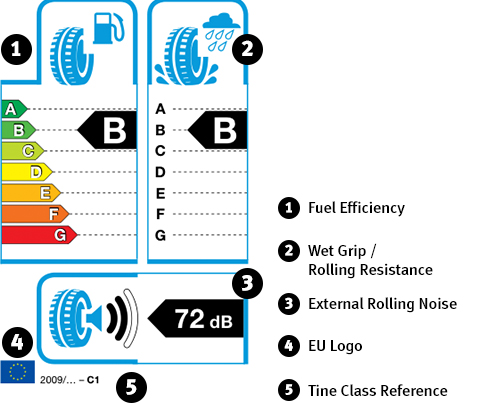
Tread Depth
When it comes to car safety, checking your tyre tread should be high on your list of priorities there are a surprising number of people driving around on our roads with illegal tyres without even realising. The legal tyre limit is 1.6mm and if you are found to be driving with illegal tyres you run the risk of a fine and penalty points. Your tyres will always be checked as part of your annual MOT and service however it is your responsibility to check them throughout the rest of the year.
We know it’s one of those tasks that you sometimes forget or vow “to do tomorrow”, however, aside from breaking the law, if your tyre tread isn’t deep enough vehicle stopping distance is dramatically increased. Your tyre will also have less contact with the road and your vehicle is at an increased risk of skidding and aquaplaning in wet weather.

Whilst the legal limit is 1.6mm, many tests have been carried out to test how safe tyres are at this tread depth .Breaking performance is surprisingly poor when a tyre has a tread depth at the legal limit. As a result of these findings, many tyre safety campaigners recommend that the legal limit be raised to 3mm to reduce the number of accidents on our roads.
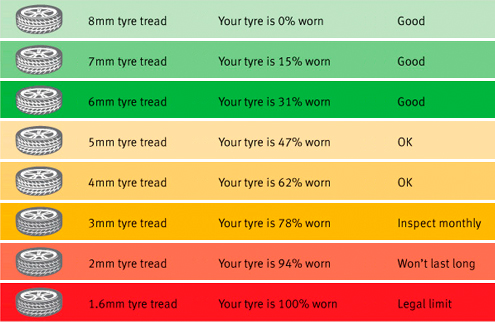
So how can you quickly check you are within the law and have safe tyres? Tyre Safe, one of the UK’s leading tyre safety organisations, recommends that you take the 20p test. The test is simple. Insert a 20p coin into the lowest tread depth of your tyres. If you can’t see the outer rim around the edge of the coin, then your tyre is safe and has a minimum of 3mm tread depth. If you CAN see the rim then your tyre tread is less than 3mm and should be checked by a professional.
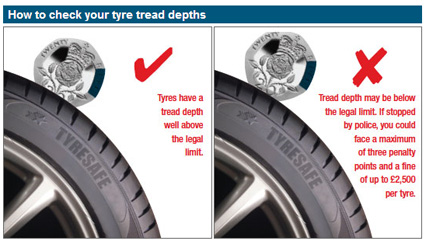
It’s important to remember that your tread depth won’t necessarily be the same all the way around your tyre, so be sure to check it in several different places. You should aim to check your tyres every two weeks – especially if you use your vehicle on a daily basis. It’s also a good idea to check your tyre pressure every two weeks too, that way, you know you will be prepared for any bad weather that comes our way!
If you are concerned about driving during wintry conditions, completing these tests is a good start in making sure your vehicle is safe. If you want to be extra sure you will be safe whilst driving this winter, you could invest in winter tyres that are specially designed to cope with snow and icy conditions.


